Aircraft camouflage
Aircraft camouflage is the use of camouflage on military aircraft to make them more difficult to see, whether on the ground or in the air. Given the possible backgrounds and lighting conditions, no single scheme works in every situation. A common approach has been a form of countershading, the aircraft being painted in a disruptive pattern of ground colors such as green and brown above, sky colors below. For faster and higher-flying aircraft, sky colors have sometimes been used all over, while helicopters and fixed-wing aircraft used close to the ground are often painted entirely in ground camouflage. Aircraft flying by night have often been painted black, but this actually made them appear darker than the night sky, leading to paler night camouflage schemes. There are trade-offs between camouflage and aircraft recognition markings, and between camouflage and weight. Accordingly, visible light camouflage has been dispensed with when air superiority was not threatened or when no significant aerial opposition was anticipated.
Aircraft were first camouflaged during World War I; aircraft camouflage has been widely employed since then. In World War II, disruptive camouflage became widespread for fighters and bombers, sometimes combined with countershading. Some air forces such as the German Luftwaffe varied their paint schemes to suit differing flight conditions such as the skyglow over German cities, or the sands of the Mediterranean front.
During and after World War II, the Yehudi lights project developed counter-illumination camouflage using lamps to increase the brightness of the aircraft to match the brightness of the sky. This was abandoned with improvements in radar, which seemed to render visible light camouflage redundant. However, aircraft continue to be painted in camouflage schemes; recent experiments have again explored active camouflage systems which allow colors, patterns and brightness to be changed to match the background, and some air forces have painted their fighters in digital camouflage patterns. Stealth technology, as in the Lockheed F-117 Nighthawk, aims to minimize an aircraft's radar cross-section and infrared signature, effectively providing multi-spectral camouflage at the price of reduced flying performance. Stealth may extend to avoiding or preventing vapor contrails.
History
World War I
The French were among the first to introduce camouflage, starting with Nieuport fighters. They later introduced a standardized disruptive camouflage scheme for other combat aircraft – such as the Breguet XIV and SPAD XIII that consisted of dark and light green, dark and light brown, black (sometimes omitted) and an underside of grey or beige.[1][2]
Like the French, the German air services used a variety of disruptive camouflage patterns until April 1917, when lozenge camouflage was introduced; it used up to five colors.[3] German aircraft were however sometimes painted in deliberately conspicuous colors, like the bright red of Manfred von Richthofen's Albatros D.III, advertising the pilot's prowess to intimidate the enemy.[4][5]
The British Royal Flying Corps and Royal Naval Air Service used black for night bombers, while a wide variety of experimental camouflages were tried out for specific roles such as trench strafing, with multiple colors. Alternatives were tested in late 1917 at Orfordness Experimental Station, resulting in NIVO (Night Invisible Varnish Orfordness) being introduced in early 1918, used for all external surfaces on night bombers until superseded by World War II colors.[6]
World War II
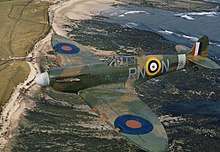
During the Munich Crisis of 1938, the Royal Air Force implemented plans to camouflage its aircraft in its disruptively patterned Temperate Land Scheme of "Dark Earth" and "Dark Green" above and "Sky" below. This scheme was known colloquially as "Sand and Spinach" when the pattern was painted on at the factory, large rubber mats serving as guides. For many types of aircraft, particularly fighters, the rubber mats were reversed for even and odd serials, named A and B patterns. The undersides of night bombers were painted black.[7][8]
Some United States Army Air Forces aircraft used a variation of the British camouflage schemes (mostly on aircraft originally built to RAF orders) but most USAAF aircraft did not use multiple shades on the top side of the aircraft. Instead, most were camouflaged in olive drab above and neutral gray below, though some had the edges of flying surfaces painted in medium green.[9] In the later stages of the war camouflage was often dispensed with, both to save time in manufacturing and to reduce weight, leaving aircraft with a natural metal finish.[10]
Soviet Air Forces aircraft were painted with shades of green, either plain or in disruptive patterns above, and blue-grey on the undersurfaces.[11][12]
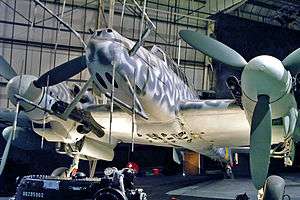
The basic German (Luftwaffe) camouflage during most of the war was based on a light blue undersurface and a two tone splinter pattern of various greens for the upper surfaces. In the first year of the war, the top colors were dark green and black-green; later, lighter and more greyish colors were used for fighters, though bombers mostly maintained the dark green/black green camouflage. The side of the fuselage on fighters and some light bombers often had irregular patches sprayed on, softening the transition from the upper to the lower surface. The undersides of night bombers and night fighters were painted black early in the war, but by 1943 switched to lighter base colors of their usual light blue undersurfaces for aircraft flown by day, and a light gray base coat over the upper surfaces to match the skyglow over the German cities they were tasked with defending.[13] A special pattern was devised for the Mediterranean front, consisting of a sand yellow that often faded to tan, with or without olive green patches. As Germany lost air supremacy, ground camouflage became increasingly important, and late war fighters received a two tone scheme like the British Sand and Spinach, in dark brown and light green.[14]
Cold War and after
.jpg)
During the Cold War, camouflage was partially abandoned; for example, glossy anti-flash white was used on aircraft as protection from nuclear flash, including high-flying Royal Air Force nuclear weapon-carrying V-bombers.[15] When SAMs made high level attack too dangerous, the plans for RAF bombers changed to low level attack and camouflaged top surfaces returned.[16] Apart from American and Soviet strategic forces, however, camouflage continued to be applied tactically. For example in the Korean War, American B-29 bombers were switched to night flying with black undersides when Chinese fighters became a significant threat.[17] In the Vietnam War, Vietcong MiG-21 fighters were painted by hand in green ground camouflage patterns,[18] while the USAAF and US Navy both restarted experiments with painted camouflage.[19] In the Soviet–Afghan War, Soviet Mil Mi-24 helicopters were camouflaged in a sand and spinach pattern.[20]
In the 1970s, heat-seeking missiles were developed that had a range greater than the visual acuity of pilots. Aircraft camouflage now had two major threats that it was not able to fully defeat—radar and infrared detection. Camouflage accordingly became less important.[21] However, by the 1980s, the human eye was again seen as sufficiently important a threat that aircraft like the ground attack A-10 Thunderbolt (Warthog) were painted in camouflage schemes that included both disruptive ground coloration and automimicry (deceptive self-imitation), in the form of a false canopy on the underside.[22][23]
Methods
.jpg)
Camouflage for aircraft is complicated by the fact that the aircraft's background varies widely, depending on the location of the observer, the nature of the background[24] and the aircraft's motion. For this reason, military aircraft were often painted to match the sky when viewed from below, and to either match the ground or break up the aircraft's outline when viewed from above. This is a form of countershading, likely to work best on aircraft such as heavy bombers that do not do fly inverted during combat.[22] Because of the way light hits it, patterns of dark and light will often be present on an aircraft even if it is entirely one color, making it easier to see[25] Reflections and specular highlights can be counteracted by painting an aircraft in neutral shades with a non-reflective, matte finish.[25] There is a trade-off between the effectiveness of camouflage and the size of recognition markings: larger markings reduce the risk of friendly fire through misrecognition, but compromise camouflage.[26]
Ground camouflage
Ground camouflage is used to delay visual acquisition from the air of an aircraft that is on or near the ground. Light sand has been used for aircraft used over deserts, blues and greys for aircraft over the sea, and greens and browns for aircraft that are expected to operate in forested areas.[27] However, a camouflaged aircraft either on the ground or flying low over the ground in bright sunlight remains vulnerable to being detected from above because of its own shadow cast on the ground.[28]> This can reduce an aircraft's camouflage effectiveness at altitudes up to 3,000 feet (910 m), particularly if the ground surface is pale and relatively uniform.[28] Helicopters are often painted in ground camouflage, sometimes in regional or seasonal forms such as snow camouflage.[29][30] Fixed-wing aircraft, too, are occasionally painted with snow camouflage, as for example on Soviet fighters[31] and Luftwaffe Stukas on the Eastern Front in winter,[32] in Swedish trials in 1970,[33] and RAF Jaguars on exercise in Norway.[34][lower-alpha 1]
Air camouflage
Camouflage for an airborne aircraft may attempt to provide concealment with colors resembling the background. For example, until 1941, Royal Air Force fighters were painted in ground colors (dark green and brown) above, and sky colors below. However, aircraft were being lost, and pilots reported that the colors used made their fighters conspicuously darker than the sky. The Air Fighting Development Unit at Duxford studied the problem, and in the summer of 1941 replaced the dark brown with a paler color, "ocean grey"; the sky blue on the underside was similarly replaced by a paler "sea grey" to reduce visibility against the bright sky. Similar adjustments were made by the Luftwaffe. Towards the end of the war, allied air superiority made visible light camouflage less important, and some American aircraft were flown in unpainted (silver colored) metal to save weight.[lower-alpha 2][10]
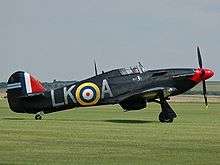
Night camouflage
Military aircraft flying at night have often been painted black or other dark colors, applied to just the underside of some aircraft and to the entirety of others, in the hope of reducing the risk of being seen in enemy searchlights or by night fighters.[36] However, aircraft camouflaged with black paint are actually darker than the night sky, making them more visible to observers not using searchlights.[21] The undersides of Heinkel 111 night bombers were painted black.[37] The De Havilland Mosquito was similarly initially painted black when used as a night fighter; matte black was found to be the best at reducing the aircraft's visibility against searchlights, but the aircraft's speed was reduced by 15mph (25kph) compared to glossy black, which, being smoother, produced less drag. Since, however, black camouflage made the planes conspicuous on moonlit nights and against cloud, a variation of a day camouflage scheme was eventually chosen.[38]
Active camouflage

In the early years of World War II, German U-boats often escaped attack by aircraft because they spotted the aircraft while it was still far away as a black dot in the sky, no matter what camouflage colors were used. To solve this problem, in 1943 the U.S. Navy, following the Canadian diffused lighting camouflage trials on warships, conducted secret experiments on counter-illumination in the Yehudi lights project. Sealed beam lights were mounted on the leading edge of the wing of a Grumman TBM-3D Avenger, and around its engine cowling, with the lamps facing forward.[lower-alpha 3][39] The intensity of the lamps was adjusted to match the background sky as seen from an observer in a surface ship. Aircraft with Yehudi lights were not detected until 2 miles (3.2 km) away under conditions where aircraft without the lights were detected 12 miles (19 km) away.[21] Though successful, the system was not put into production because of improved radar detection.[21]
During the Vietnam War, Yehudi lights were again tried, this time mounted to an F-4 Phantom painted in a dull blue-and-white camouflage pattern. The experiment reduced by 30% the distance at which an observer visually acquired the Phantom. In 1997, active camouflage was again investigated, this time with thin computer-controlled fluorescent panels or light-emitting polymer covering much of an aircraft's surface.[21][40]
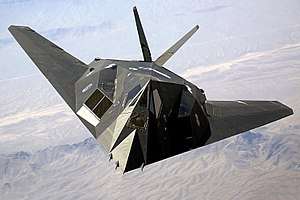
Stealth technology
Stealth technology aims to make aircraft almost undetectable by radar or other sensors, whether infrared, visible, or acoustic. This is effectively multi-spectral camouflage.[41] Work began on stealth technology in America in 1958.[42][43]
The Lockheed F-117 Nighthawk was the first operational aircraft designed to use stealth technology to minimize its radar cross-section; it began operations in secrecy in 1983.[44] Its low detectability was traded-off against performance in other areas, including reduced thrust and only subsonic speed.[45] The aircraft's faceted shape reduced the reflection of radar back to the receiver, at the expense of making the aircraft aerodynamically unstable, requiring a fly-by-wire flight system to maintain controlled flight.[46] The infrared signatures of stealth aircraft can be reduced by designing exhaust nozzles to mix the hot gases with cool ambient air, by placing the nozzles above the wing to conceal them from ground-based observers, and by avoiding the use of afterburners, as with the Northrop Grumman B-2 Spirit bomber.[47]
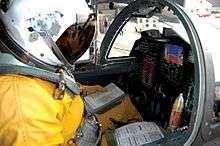
Preventing contrails
Camouflage may extend beyond an aircraft's airframe. High-flying aircraft can sometimes be detected by their vapor contrails. Researchers have considered whether these might be reduced with the use of chemical additives.[48] Work was carried out on a contrail management system for B-2 stealth bombers in 1994.[49][50] From the Second World War onwards, reconnaissance pilots took care to avoid creating contrails, varying their altitude as necessary; the Lockheed U-2 reconnaissance aircraft was equipped with a mirror to enable the pilot to see if the plane was creating a contrail, and to take action accordingly.[51]
Digital camouflage
Digital camouflage patterns, widely used for uniforms with designs such as CADPAT and MARPAT,[52] have been applied to the aircraft of some armed forces. For example, Jordan has painted its F-16 fighters in a digital pattern, and in 2008 Slovakia repainted its MiG-29 fighters in a disruptive pattern designed by HyperStealth, "Digital Thunder".[53][54] In 2017, a prototype of the Russian air force's Sukhoi Su-57 flew with a countershaded digital camouflage scheme, all dark above except for a multi-scale pattern at the edges.[55]
See also
Notes
- ↑ A Jaguar in a winter scheme can be seen at File:Sepecat Jaguar GR1A, UK - Air Force AN1985498.jpg.
- ↑ The weight saved and any consequent improvement in speed or range depends on the aircraft type. Defense Media Network calculated that a Boeing B-17 Flying Fortress carried some 300 pounds of paint, on the basis of a painted area of 4200 square feet. That needed some 35 gallons of lead-based paint weighing some 10 pounds per gallon, giving a wet weight of 350 pounds and a dry weight of perhaps 300 pounds after evaporation. The article noted that contemporary reports were more conservative, estimating 15 – 20 pounds for a fighter, 70 – 80 pounds for a bomber. The article also noted that planes with polished surfaces tested by Proving Ground Command in November 1942 flew 8 mph faster than when they were painted.[35]
- ↑ To keep the lamps pointing towards the target (such as a surfaced submarine) in a crosswind, pilots had to fly in a curving path rather than straight towards the target.[39]
References
- ↑ Hardesty, Bergen F.; Hastings, H. D.; Toelle, Alan D. (1968). "Project Butterfly". Cross & Cockade (US). 9 (1).
- ↑ Hardesty, Bergen F.; Hastings, H. D.; Toelle, Alan D. (1972). "Project Butterfly". Cross & Cockade (US). 13 (2).
- ↑ Newark 2007, pp. 68–69.
- ↑ Guttman, Jon (2009). Pusher Aces of World War 1. Osprey. p. 63. ISBN 978-1-84603-417-6.
- ↑ Tucker, Spencer C. (2016). World War II: The Definitive Encyclopedia and Document Collection [5 volumes]. ABC-CLIO. p. 337. ISBN 978-1-85109-969-6.
- ↑ Richardson, Doug (2001). Stealth Warplanes: Deception, Evasion, and Concealment in the Air. Zenith. pp. 15–16. ISBN 0-7603-1051-3.
- ↑ Holmes, Tony (1998). Hurricane aces, 1930–40 (Reprint ed.). London: Osprey Aerospace. ISBN 1-85532-597-7.
- ↑ Derry, Martin; Robinson, Neil (2014). Avro Lancaster 1945–1965: In British, Canadian and French Military Service. Pen and Sword. p. 102. ISBN 978-1-4738-5104-7.
Bomber Command was of the opinion that the application of the current Temperate Land Scheme of Dark Green and Dark Earth to the upper surfaces was a waste of time and labour.
- ↑ Scutts, Jerry; Green, Brett (2003). World War 2 US Army Fighter Modeling. Modelling Masterclass. Osprey Publishing. p. 92. ISBN 1-84176-061-7.
- 1 2 Newark 2007, p. 144.
- ↑ Hornat, Jiri (2006). Colors Of The Falcons. Soviet Aircraft Camouflage & Markings In World War II. Iliad Design. ISBN 978-0-973-99940-2.
- ↑ Pilawskii, Erik (2004). Soviet Air Force Fighter colors 1941–45. Classic Publications. ISBN 978-1-903-22330-7.
- ↑ Price, Alfred (1967). Aircraft in Profile No.148 — The Junkers Ju 88 Night Fighters. Leatherhead: Profile Publications. p. 16.
- ↑ Ullmann, M. (2000): Oberflächenschutzverfahren und Anstrichstoffe der deutschen Luftfahrtindustrie und Luftwaffe 1935–1945. Bernard & Graefe, ISBN 3-7637-6201-9
- ↑ "B36 in "anti-atom" finish over Kent". Flight: 741. 11 November 1955.
- ↑ Flintham, Vic (2008). High Stakes: Britain's Air Arms in Action 1945–1990. Pen and Sword. p. 133. ISBN 1-8441-5815-2.
- ↑ Neufeld, Jacob; Watson, George M. (2007). Coalition Air Warfare in the Korean War, 1950 1953: Proceedings Air Force Historical Foundation Symposium, Andrews AFB, Maryland May 7-8, 2002. Government Printing Office. p. 27. ISBN 978-0-16-075367-1.
- ↑ Toperczer, István (2012). MiG-21 Units of the Vietnam War. Bloomsbury Publishing. pp. 91–92. ISBN 978-1-78200-749-4.
- ↑ Morgan, Rick (2012). A-6 Intruder Units of the Vietnam War. Bloomsbury Publishing. pp. 19, 20, 91. ISBN 978-1-84908-756-8.
- ↑ Isby, David (2013). Russia’s War in Afghanistan. Bloomsbury Publishing. p. 83. ISBN 978-1-4728-0179-1.
- 1 2 3 4 5 Douglass, Steve; Sweetman, Bill (1997). "Hiding in Plane Sight: Stealth aircraft own the night. Now they want the day". Popular Science (May 1997): 54–59.
- 1 2 Shaw 1985, p. 382.
- ↑ Neubeck, Ken (1999). A-10 Warthog Walk Around. Squadron/Signal Publications. pp. 72–77, 92. ISBN 0-89747-400-7.
- ↑ Shaw 1985, p. 380.
- 1 2 Shaw 1985, p. 381.
- ↑ "FM 3-01.80 (FM 44-80) Visual Aircraft Recognition" (PDF). Department of the Army. 2006. pp. 2–5. Retrieved 6 February 2017.
However, ground observers must deal with camouflage patterns because the patterns break up aircraft outlines, making aircraft more difficult to recognize and identify.
- ↑ Cowley, Robert; Parker, Geoffrey (2001). The Reader's Companion to Military History. Houghton Mifflin Harcourt. pp. 68–69. ISBN 0-618-12742-9.
- 1 2 Shaw 1985, p. 383.
- ↑ Humphreys, Adolph H.; Jarvis, Sharon V. (1 February 1974). "Camouflage Pattern Painting Report of Usamerdc's Camouflage Support Team to Masster" (PDF). DTIC. Retrieved 18 March 2017.
- ↑ U.S. DefenseImagery photo VIRIN: DA-SD-01-10113, 1986
- ↑ Dougherty 2017, p. 149.
- ↑ Newdick, Thomas (2015). The World’s Greatest Military Aircraft: An Illustrated History. Amber Books. p. 42. ISBN 978-1-78274-277-7.
- ↑ Hagedorn, Dan (2009). North American's T-6: A Definitive History of the World's Most Famous Trainer. Specialty Press. p. 209. ISBN 978-1-58007-124-6.
- ↑ Spick, Mike; Wheeler, Barry (1992). Modern Aircraft Markings. Smithmark. p. 149. ISBN 978-0-8317-5058-9.
- ↑ Zimmerman, Dwight John (23 February 2014). "The U.S. Army Air Forces Strips Its Planes of Paint". Defense Media Network.
- ↑ Stephenson, Hubert Kirk. (1948) Applied Physics, pp. 200, 258. Science in World War II; Office of Scientific Research and Development. Volume 6 of Science in World War II (Atlantic Monthly Press Book). Editors: Chauncey Guy Suits and George Russell Harrison. Little, Brown.
- ↑ Lepage, Jean-Denis G.G. (2009). Aircraft of the Luftwaffe, 1935–1945: An Illustrated Guide. McFarland. p. 47. ISBN 978-0-7864-5280-4.
- ↑ Birtles, Philip (2017). De Havilland Mosquito: The Original Multirole Combat Aircraft. Fonthill Media. p. 209. GGKEY:XL1896UPHXD.
- 1 2 Bush,, Vannevar; Conant, James; et al. (1946). "Camouflage of Sea-Search Aircraft" (PDF). Visibility Studies and Some Applications in the Field of Camouflage. Office of Scientific Research and Development, National Defence Research Committee. pp. 225–240. Retrieved February 12, 2013.
- ↑ Shaw 1985, p. 55.
- ↑ Rao, J. V. Ramana (1999). "Introduction To Camouflage And Deception". New Delhi: Defence Research & Development Organisation. p. 4.
The conventional methods of camouflage and deception are no longer adequate in the present-day advanced technology warfare scenario. The field has acquired new dimensions under the names such as stealth technology, low observable technology, very low observable technology, or signature management. In this context, the conventional methods of camouflage, concealment and deception serve only the preliminary stages. The concept of multispectral/ polyspectral camouflage under the name stealth technology has to embody countermeasures to detection by radar, infrared, visible and acoustic sensors and any other sensor that may be employed.
Missing or empty|url=(help) - ↑ Richelson, J.T. (10 September 2001). "Science, Technology and the CIA". The National Security Archive. The George Washington University. Retrieved 8 March 2017.
- ↑ Merlin, P.W. (2009). Design and Development of the Blackbird: Challenges and Lessons Learned. 47th AIAA Aerospace Sciences Meeting Including The New Horizons Forum and Aerospace Exposition 5–8 January 2009, Orlando, Florida. American Institute of Aeronautics and Astronautics. Archived from the original on 2013-05-11. Retrieved 2017-09-08.
- ↑ "Lockheed F-117A Nighthawk". National Museum of the United States Air Force. Retrieved 8 March 2017.
- ↑ Sweetman, Bill (2007). "Unconventional Weapon". Air & Space (December 2007/January 2008). Archived from the original on 2012-07-19.
- ↑ Rich, Ben (1994). Skunk Works. Back Bay Books. pp. 30–31, 46. ISBN 0-316-74330-5.
- ↑ Kopp, Carlo (1989). "Optical Warfare – The New Frontier" (November 1989/January 1990). Air Power Australia. Retrieved 8 March 2017.
- ↑ "How to disappear". The Economist (Technology Quarterly Q3 2008). 4 September 2008. Retrieved 29 March 2017.
- ↑ Axe, David (13 December 2012). "7 Secret Ways America's Stealth Armada Stays Off the Radar". Wired. Retrieved 29 March 2017.
- ↑ Vartabedian, Ralph (2 February 1994). "Trail at End of B-2 Leads to Northrop Contract : Aircraft: Air Force will pay $63.5 million to get rid of the wispy white contrails that give away stealth bomber's location". Los Angeles Times. Retrieved 29 March 2017.
- ↑ Pocock, Chris (2005). 50 Years of the U-2: The Complete Illustrated History of the "Dragon Lady". Schiffer Military History. pp. 151, 174, 249. ISBN 978-0-7643-2346-1.
- ↑ Billock, Vincent A; Cunningham, Douglas W.; Tsou, Brian H. (2010). Andrews, Dee H.; Herz, Robert P.; Wolf, Mark B., ed. Human Factors Issues in Combat Identification. What Visual Discrimination of Fractal Textures Can Tell Us about Discrimination of Camouflaged Targets. Ashgate. pp. 99–101. ISBN 9781409486206.
- ↑ "Mig-29 in HyperStealth Digital Thunder Disruption Camouflage". HyperStealth. 21 March 2008.
- ↑ no byline, staff editors (25 March 2008). "'Digital Thunder' Camo for Slovakia's MiG-29s". Defense Industry Daily.
- ↑ "PAK FA and Su-35S: The Future of the Russian Air Force". Defense-Aerospace.com. Retrieved 16 June 2017.
Sources
- Dougherty, Martin J. (2017). Camouflage At War: An Illustrated Guide from 1914 to the Present Day. Amber Books. ISBN 978-1-78274-498-6.
- Newark, Tim (2007). Camouflage. Thames and Hudson, with Imperial War Museum. ISBN 978-0-500-51347-7.
- Shaw, Robert (1985). Fighter combat: tactics and maneuvering. Naval Institute Press. ISBN 0-87021-059-9.
Further reading
- Robertson, Bruce (1966). Aircraft camouflage and markings, 1907–1954 (Sixth ed.). Aero Publishing. ISBN 0-8168-6355-5.
External links
| Wikimedia Commons has media related to Aircraft camouflage. |
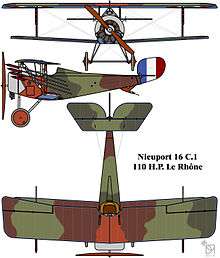
.jpg)